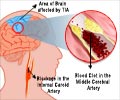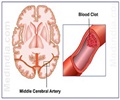The US Food and Administration has approved a new robotic device called the Myomo e100, designed to help stroke patients regain motion in their arms.
Robotic devices, that help stroke patients practise daily tasks with impaired limbs, are proliferating in US.
The US Food and Administration has approved a new robotic device called the Myomo e100, designed to help stroke patients regain motion in their arms. It is to hit the market shortly.Worn as an arm brace, the device works by sensing weak electrical activity in patients’ arm muscles and providing just enough assistance that they can complete simple exercises, like lifting boxes or flipping on light switches. By practicing such tasks, patients may begin to relearn how to extend and flex the arm, rebuilding and strengthening neurological pathways in the process.
“The device is designed to help get patients over a functional hump” so they can start moving the weakened arm again, said John McBean, a mechanical engineer who developed the technology with Kailas Narendran, an electrical engineer and computer scientist.
(The two began the project in 2002, in a graduate robotics class at Massachusetts Institute of Technology (M.I.T).)
“And the more they are able to use the arm, the more improvement they begin to see,” McBean continued. “So it’s a virtuous cycle.”
“This is an area that’s exploding,” said Hermano Igo Krebs, a principal research scientist at M.I.T. and one of the first scientists to envision robot-assisted therapy for stroke patients and others with brain injuries and neurological disorders.
Advertisement
Some 700,000 US citizens suffer strokes every year. Of these, some 500,000 require therapy for problems with language, memory or movement. It is the last aspect that is the focus of M.I.T. robots.
Advertisement
“At first it felt weird and foreign,” she said. “You have all these little muscles that are suddenly awake for the first time in 20 years. But as I went back and practiced” — three times a week for about six weeks — “it felt like my arm was doing the straightening and bending itself, just with some assistance.”
“It was extremely encouraging,” she added, noting that with the brace on she was able to practice tasks like folding towels, opening drawers and lifting a yoga mat from a chair to a table. One time, she was delivering mail at work (she is an administrative assistant at a medical software company) and the envelopes started to slip. “And my left arm shot out to catch them,” she recalled. “That hadn’t happened in years.”
A small study of the Myomo device and associated treatment, conducted with Spaulding Rehabilitation Hospital in Massachusetts and published in April in The American Journal of Physical Medicine and Rehabilitation, found that patients who exercised with the arm brace for 18 hours over about six weeks experienced a 23 percent improvement in upper extremity function.
Further clinical testing with stroke patients is under way at the Braintree Rehabilitation Hospital in Massachusetts. And a study involving patients with spinal cord injury and traumatic brain injury, including veterans of the Iraq war, is in the planning stages at the James A. Haley Veterans’ Hospital in Tampa, Fla.
It is not yet clear whether movement therapy using a surface-controlled device like the Myomo brace will benefit these patients, said Dr. Irene M. Estores, a specialist in spinal cord injury and in physical medicine and rehabilitation at that hospital. But in the long run, the device (and others like it) could also prove useful as a “power assist” that patients wear every day.
A renewed ability to flex and extend at the elbow would be especially important to patients who also cannot walk and who may otherwise have to rely on a mouth stick to move their wheelchairs, Dr. Estores added.
Veterans Administration is sponsoring a large multicenter trial of new devices for the shoulder, elbow, wrist and hand, which began last November.
These devices generally do not take cues from electrical muscle activity, as the Myomo brace does, but depend instead on the observed motion (or lack of motion) of patients’ limbs. This means they can be used by patients with no electrical activity in a paralyzed limb. Dr. Hermano Igo Krebs, a pioneer in the field, notes that for stroke patients, a large body of evidence now suggests that repeated practice with an impaired limb can foster plastic changes in the brain. In other words, it can help the brain forge new connections between neurons or strengthen existing ones. For patients whose strokes have damaged part of the motor cortex and subcortex, this means that movement therapy may help the brain to use other, nearby neurons — or even neurons in the opposite brain hemisphere — to complete a movement.
“The goal is to make neurons talk to each other again,” said Dr. Krebs, adding that even patients who cannot move initially may benefit from making an attempt, then seeing and feeling the intended movement carried through with the aid of the robot. This experience, it turns out, may be a crucial part of the relearning process.
Robotic devices are also well suited to repetitive movement therapy because “they can do the same thing two million times with perfect consistency,” said Dr. Steven C. Cramer, a neurologist at the University of California.
His team uses computer games to make the practice less tedious. In one application, as patients grasp and release their hands, an image shows a hand squeezing lemons or stealing jewels.
Moving forward, Dr. Cramer said, researchers must keep an eye on safety to ensure vulnerable patients do not get hurt. He added that he did not expect robotic devices to completely replace human therapists.
Source-Medindia
GPL/M











